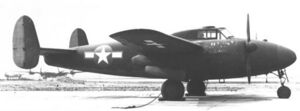Engineering:Fairchild BQ-3
| XBQ-3 | |
|---|---|

| |
| Role | Flying bomb |
| National origin | United States |
| Manufacturer | Fairchild Aircraft |
| First flight | July 1944 |
| Primary user | United States Army Air Forces |
| Number built | 2 |
| Developed from | AT-21 Gunner |
The Fairchild BQ-3, also known as the Model 79, was an early expendable unmanned aerial vehicle – referred to at the time as an "assault drone" – developed by Fairchild Aircraft from the company's AT-21 Gunner advanced trainer during the Second World War for use by the United States Army Air Forces . Two examples of the type were built and flight-tested, but the progress of guided missiles rendered the assault drone quickly obsolete, and the type was not produced.
Design and development
Development of the BQ-3 began in October, 1942, under a program for the development of "aerial torpedoes", later and more commonly referred to as "assault drones",[1] that had been instigated in March of that year. Fairchild was awarded a contract for the construction of two XBQ-3 prototypes, based largely on the AT-21 Gunner advanced gunnery trainer already in United States Army Air Forces service.[1]
The XBQ-3 was a twin-engined, low-wing aircraft, fitted with retractable tricycle landing gear and a twin-finned empennage; although the aircraft was intended to be operated by radio control with television assist, a two-seat cockpit was included in the design for testing and ferry flights.[2] Power was provided by two Ranger V-770 inline piston engines of 520 horsepower (390 kW) each;[3] up to 4,000 pounds (1,800 kg) of explosives could be carried by the aircraft in unmanned configuration.[2] Like the contemporary Fleetwings BQ-2, the aircraft would be destroyed in the act of striking the target.
Flight testing
The first flight of the XBQ-3 took place in July 1944;[1] later that month, one of the prototypes was severely damaged in a forced landing.[4] Despite the accident, flight testing continued; however, the assault drone was determined to have no significant advantage over conventional bombers, and advances in the field of guided missiles were rapidly rendering the concept obsolete.[5] As a result, the program was cancelled towards the end of 1944.[1]
Specifications (XBQ-3)
Data from [1]
General characteristics
- Crew: 1 (optional)
- Length: 52 ft 8 in (16.05 m)
- Wingspan: 37 ft (11 m)
- Height: 31 ft 1 in (9.47 m)
- Gross weight: 15,300 lb (6,940 kg)
- Powerplant: 2 × Ranger V-770-15 inline piston engines, 520 hp (390 kW) each
Performance
- Maximum speed: 220 mph (350 km/h, 190 kn)
- Range: 1,500 mi (2,400 km, 1,300 nmi)
Armament
- 4,000 pounds (1,800 kg) warhead
See also
Related development
Aircraft of comparable role, configuration and era
References
Further reading
- Bridgman, Leonard, ed (1947). Jane's All the World's Aircraft 1947. London: MacMillan.
- The Army Air Forces in World War II. VI, Men & Planes. Chicago, IL: University of Chicago Press. 1955.
- Parsch, Andreas (2003). "Fairchild BQ-3". Directory of U.S. Military Rockets and Missiles, Appendix 1: Early Missiles and Drones. designation-systems.net. http://www.designation-systems.net/dusrm/app1/bq-3.html.
- Ross, Frank (1951). Guided Missiles: Rockets & Torpedoes. New York: Lothrop, Lee & Shepard. https://archive.org/details/guidedmissilesro00ross.
- Werrell, Kenneth P. (1985). The Evolution of the Cruise Missile. Maxwell AFB, Alabama: Air University Press. ISBN 978-1478363057.
 |

